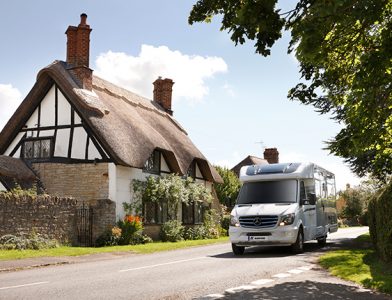At Derby Motorhomes, there’s nothing we enjoy doing better than helping our clients and potential clients learn more about motorhomes. So, we’ve built up quite an extensive database of frequently asked questions or “motorhome FAQs”.
We couldn’t do better than to share some of those frequently asked questions.
Do I need a special licence to drive a motorhome?
The answer is just a little more complicated than you might have imagined and depends on your age, when you passed your driving test, and the weight of the motorhome you intend to drive.
Please visit the Government website here for the most up to date information.
How easy are motorhomes to drive?
In terms of the basics, they’re not significantly different from a car, and most or all of the controls will be familiar. The designers have also put huge amounts of effort into making them easy to drive.
It’s worth remembering, however, that once they’re fully laden, they’ll be much heavier than most conventional cars and their handling characteristics will be different as a result. It’s not a question of easier or harder, it’s just that they’ll feel “different”.
The larger the motorhome you choose, the more you’ll notice that handling difference over and above a car.
Almost everybody gets to grips with this very quickly. There are courses you can take to help, and they might be advisable – particularly for the larger motorhomes. Motorhome manoeuvring courses are offered both by the Caravan and Motorhome Club and by the Camping and Caravanning Club.
Don’t also forget that you may need to change your driving licence category (as we explained above).
What are these giant US motorhomes I see on TV?
In the US, motorhomes are typically called “Recreational Vehicles” or “RVs”.
Some are almost the length and weight of an articulated lorry, and biggest of these types of US RV would not be road-legal in the UK or EU.
Some that are imported into the UK are road-legal, of course. Keep in mind that parts and servicing might be an issue and that in some cases they may not be drivable with a standard licence.
Are the bigger motorhomes the most expensive?
This one is commonly encountered in motorhome FAQs – and, as a general rule, of course, the answer is yes – but that’s not always the case.
For example, a slightly smaller model that’s a prestigious marque and superbly and luxuriously equipped might command a higher price than a slightly larger campervan.
It’s rather like comparing say a small Porsche to a large Ford. In the case of some campervans, you’re paying for engineering, build quality and design, not its cubic volume inside.
Can I drive my motorhome anywhere, on any public road?
Yes! Of course, you will have to comply with any road signs indicating that there is a limit on height or weight of a vehicle (if your motorhome exceeds it).
Some “unmade-up” roads in poor condition or off-road tracks might also be unadvisable for larger vehicles, including motorhomes. That’s largely a question of common sense.
Is it cheaper to buy a motorhome second hand?
It is – but subject to a couple of caveats:
- motorhomes hold their values well if they’ve been looked after. Don’t expect to see the same percentage depreciation on a two-year-old motorhome as you might expect to see with a two-year-old car;
- be sensible when purchasing a second-hand motorhome from a private individual. Unless you’re an expert, that could be risky in mechanical terms, and you’ll get little or no post-sales support.
As a final tip, of course, remember that if a second-hand motorhome price from a private seller seems too good to be true – that is highly likely to be the case.
Why do I see advertisements for seasonal motorhome storage?
Comparatively few people wish to use their motorhomes in the winter months.
Just like any other vehicle that’s parked-up and not in use, the weather can start to take its toll. Given the cost of such vehicles, many owners prefer to put them into secure and weather-proof storage units over the winter months.
Your insurance provider might also offer you discounts for doing so!
How do I find places to park or stay overnight in a motorhome?
You can stay at designated motorhome and caravan parks, which offer various facilities like waste disposal, water refill stations, and electric hook-ups. Some apps and websites also list free or low-cost overnight parking spots, such as pub car parks. However, always ask permission before parking on private land.
When parking up your motorhome, make sure you meet your obligations under any motorhome insurance policy you have – there may be stipulations as to where you can and cannot park up.
What facilities do campsites in the UK offer for motorhomes?
Most campsites provide electric hook-ups, water refill stations, waste disposal points, showers, and laundry facilities. Some higher-end sites may offer Wi-Fi, restaurants, or leisure facilities. It’s a good idea to research and book in advance, especially during peak seasons.
How do I manage water and waste in a motorhome?
Your motorhome will have a freshwater tank for drinking and washing, and a greywater tank for wastewater from sinks and showers. Waste tanks need to be emptied regularly at designated disposal points. Always refill your freshwater tank and empty waste tanks before hitting the road.
What size motorhome is right for me?
This depends on your travel plans and how many people will be using the motorhome. Smaller motorhomes or campervans are more manoeuvrable and easier to park, making them ideal for couples or solo travellers. Larger motorhomes offer more living space and amenities, but may be harder to drive and park.
How do motorhomes handle heating and hot water?
Most motorhomes are equipped with a dual-fuel heating system that uses gas and electric power to keep the interior warm and heat water for showers and sinks. Some modern motorhomes even come with underfloor heating for added comfort during colder months.
What is the difference between a motorhome and a campervan?
A motorhome is usually larger and comes with more built-in amenities, such as a full kitchen, shower, and fixed sleeping areas. Campervans are smaller, more compact, and often have fewer facilities, making them easier to drive and park in urban areas.
Can I use a motorhome in the winter?
Yes, motorhomes are suitable for year-round travel if properly equipped. Look for features like insulation, a reliable heating system, and double-glazed windows. Make sure to winterise your motorhome when temperatures drop, such as draining water systems to prevent freezing.
How much does it cost to insure a motorhome in the UK?
Motorhome insurance costs vary depending on factors such as the motorhome’s value, your driving history, and how often you use it. Policies typically cover accidental damage, theft, breakdowns, and third-party liability. Some providers also offer optional extras, like European travel cover.
How do I prepare my motorhome for long-term storage?
If you’re not using your motorhome for an extended period, you’ll need to take steps to prepare it for storage. This includes draining water systems, disconnecting the battery, cleaning the interior and exterior, and covering vents to prevent pests from getting inside. Consider using a breathable motorhome cover to protect it from the elements.
Is a shower going to work properly?
Yes, but you will need to be realistic – particularly in the smaller motorhomes.
Water is heavy and takes up a lot of space. As such, the supply is limited, and you’ll want to use it sparingly while on the road. That means that those long, high-pressure showers you take at home are unlikely to be matched by the shower experience in most motorhomes.
Having said that, most people find them perfectly adequate.
We hope these motorhome Faqs have proved useful!




